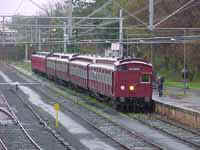

History
Beginnings...Originally constructed by the Melbourne and Essendon Railway Company, the line was opened to Essendon on the 1st November 1860. There were 5 intermediate stations, Kensington, Newmarket, Ascot Vale, and Moonee Ponds.
Flemington Racecourse
Another station was built at "Saltwater river" on the city side, and served as the stopping point for racegoers in 1859. This station was closed in 1867 after the Flemington Racecourse spur opened from Newmarket on February 28, 1861. This preceded the Melbourne Cup by 8 Months, the first being held in November of that year. In 1883 another station was opened on this line to serve the Royal Melbourne Showgrounds.
Problems
In mid 1864 the line was closed, when the Melbourne and Essendon Railway was refused money from the government, for them to continue. The line was sold to the government for $45,000 in 1867, at that stage it was in a serious state of disrepair beyond Newmarket. The Flemington Racecourse line was re-opened in time for the 1867 Melbourne Cup and after 7 years, in 1871, the line was finally re-opened to Essendon.
Onward to Broadmeadows
The 'North East line' was extended in sections beyond Essendon in 1872-73. The line was open as far as Wodonga on November 21, 1873. Broadmeadows was the only other station at this time, others were progressively added;
Glenbervie (1922), Strathmore (North Essendon - 1890), Pascoe Vale (1885), Oak Park (1956), Glenroy (1887), Jacana (1959) and Broadmeadows (1873).Electrification
Electrification was commenced in 1913, with the building of the Newport Power station, and then the subsequent substations were built along the line. The first trains along the Flemington Racecourse Line from Newmarket on October 6 1918, which was used for training purposes. The first train from Flinders Street to Essendon ran on May 28, 1919. That train then ran to Sandringham, on the only other electrified line at that time.
The Overhead was extended to its present terminus at Broadmeadows, and opened on September 4, 1921.Privatisation
Privatisation of Public Transport lead to the suburban system being split to be sold as two separate companies.
The Broadmeadows Line went to(now
), and the Flemington Racecourse Line went to
(now
)
(NE) was announced as the successful bidder for Bayside Trains on Friday, June 25, 1999. Control of the system was subsequently handed over in late August. Melbourne Transport Enterprises (MTE) won the Hillside Trains Franchise in July 1999. MTE is the result of a partnership between CGEA and ALSTOM.
The Future, Craigieburn and the Airport...
Over the years, plans have been put forward to extend the overhead to Craigieburn. Now that a Labor government has been elected, it seems that the this may finally go ahead.
Plans have also been made for a spur line to Melbourne Airport, branching just after Broadmeadows, but this has been put on the backburner, with other routes currently being considered. The plan would see the line upgraded to 3 tracks from Newmarket through to Broadmeadows, to allow express running of Airport trains at 130km/h.
Whatever happens, extension or no extension, these are certainly exciting times on the Broadmeadows Line.
References
Early History:
Trains, Tracks, Travelers, Marc Fiddian, 1997
A MUST HAVE book for all railfans!
